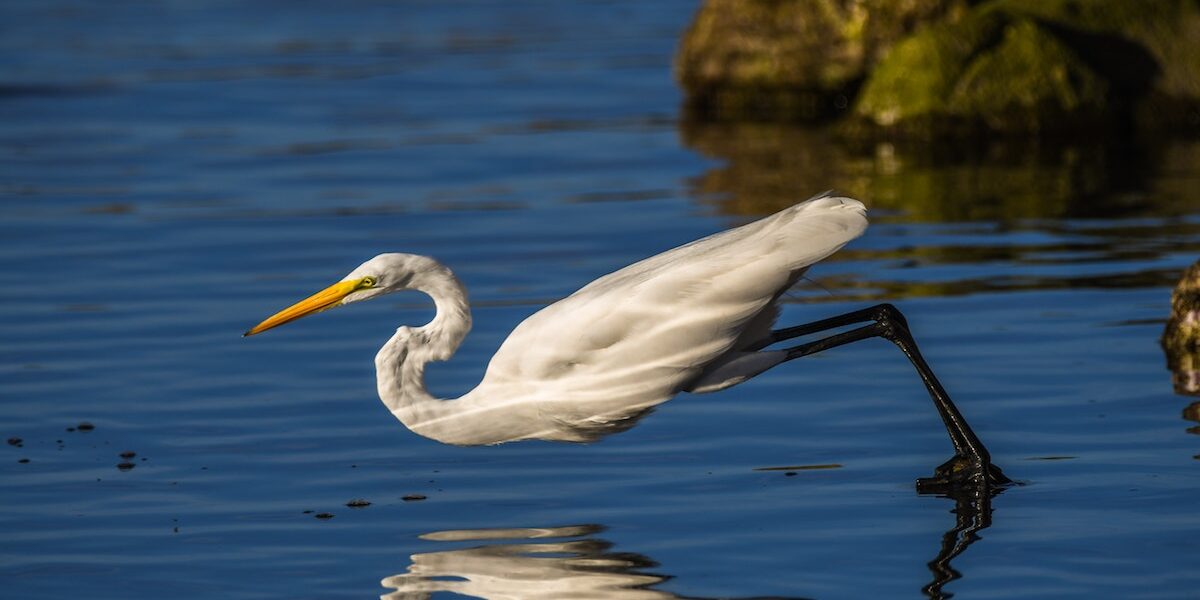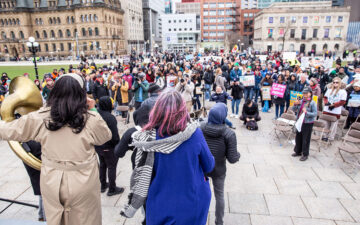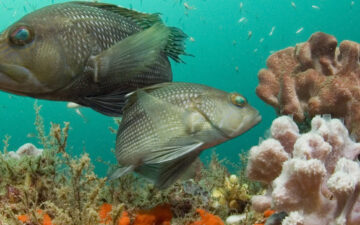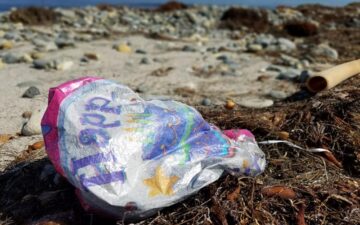by Mark J. Splading
I am sitting in front of a hotel in Loreto, Baja California Sur, Mexico watching frigate birds and pelicans gorging themselves on a run of fish. The sky is clear bright teal, and the calm Sea of Cortez is a wonderful deep blue. The arrival of the last two evenings here has come with the sudden appearance of clouds, thunder and lightening on the hills behind the town. A lightening storm in the desert is always one of nature’s best shows.
This trip marks the end of a summer of travel, which seems to ensure reflection on the last three months. The ocean season for us in the Northern Hemisphere is always busy for us at The Ocean Foundation. This summer was no exception.
I started the summer in May here in Loreto, and then included California, as well as St. Kitts and Nevis in my travels. And somehow in that month we also held our first two events to introduce TOF and highlight a few of our grantees: in New York, we heard from Dr. Roger Payne, renowned whale scientist, and in Washington, we were joined by J. Nichols of Pro Peninsula, renowned sea turtle specialist, and Indumathie Hewawasam, marine specialist of the World Bank. We were grateful at both events to serve sustainably caught seafood from Alaskan fishermen, members of the Alaska Marine Conservation Council, under its “Catch of the Season” program.
In June, we co-sponsored the first ever Conference on Ocean Literacy in Washington DC. June also included Capital Hill Oceans Week, the annual Fish Fest, and a trip to the White House to be part of the ceremony for the creation of the Northwest Hawaiian Islands National Monument. Thus was established the biggest marine reserve in the world, protecting thousands of square miles of coral reefs and other ocean habitat and the home of the last few hundred Hawaiian Monk Seals. Through its grantees, The Ocean Foundation and its donors played a small role in helping to promote its establishment. As a result, I was particularly pleased to be at the White House to watch the signing with some of those who worked so hard and for so long for this day.
The month of July began in Alaska with a special tour of the Kenai Fjords National Park with other funders, and ended in the South Pacific. A week in Alaska was followed by a trip to California, and a long reach (for those who know their Boeing 747s lore) to Australia and Fiji. I will tell you more about the Pacific Islands below.
August included coastal Maine for some site visits along the coast and New York City, where I met with Bill Mott who heads The Ocean Project and his advisor Paul Boyle, head of New York Aquarium, to talk about the work plan for his organization now that it’s housed at TOF. Now, coming full circle, I am in Loreto for the fourth time this year to both continue the work of TOF’s Loreto Bay Foundation Fund, but also to celebrate an anniversary and a new beginning. This week included the commemoration of the 10th anniversary of the establishment of the Loreto Bay National Marine Park, but also the groundbreaking ceremony for Loreto’s new environmental center (a project of our grantee, Grupo Ecologista Antares). I have also had the opportunity to meet with the new manager of the Inn at Loreto Bay, who is charged with making the hotel and its operations more sustainable and who has fully embraced encouraging visitors to participate by becoming donors to The Loreto Bay Foundation fund. In meetings with the mayor, we discussed some of the ongoing issues that affect the health of the community and organizations that are being established to address them: youth health, fitness, and nutrition (a comprehensive program of the new soccer association); alcohol and other addictions (new residential and outpatient programs are evolving); and general educational program improvement. Addressing these issues is critical to ensuring community engagement in longer-term thinking about sustainable use and management of the region’s natural resources on which they also depend.
THE PACIFIC ISLANDS
The day I arrived in Australia, Geoff Withycombe, Chair of the Board of TOF grantee, Surfrider Foundation Australia, picked me up for a meeting marathon, thoughtfully arranged by Geoff to make the most of my brief time in Sydney. We met with the following entities:
- Ocean Watch Australia, a national environmental, not-for-profit company that works to achieve sustainability in the Australian seafood industry through protecting and enhancing fish habitats, improving water quality and building sustainable fisheries through action-based partnerships with the Australian seafood industry, government, natural resource managers, private enterprise and the community (with offices located in the Sydney Fish Markets!).
- Environmental Defender’s Office Ltd., which is a not-for-profit community legal center specializing in public interest environmental law. It helps individuals and community groups who are working to protect the natural and built environment.
- Sydney Coastal Councils, which focus on coordinating 12 Sydney area coastal community councils trying to work together toward a consistent coastal management strategy.
- A behind the scenes tour and meeting at Ocean World Manly (owned by the Sydney Aquarium, in turn owned by Attractions Sydney) and the Ocean World Conservation Foundation.
- And, of course, a lengthy update on Surfrider Australia’s work to improve coastal water quality, clean up beaches, and protect surf breaks with a mostly volunteer staff and a lot of enthusiasm.
Through these meetings, I learned more about the coastal management issues in Australia and how the governance and funding mechanisms work. As a result we see that over time there will be opportunities to support these groups and others. In particular, we made an introduction between Bill Mott of The Ocean Project and the staff at Ocean World Manly. There may also be an opportunity to do work with these groups in way that is consistent with our portfolio of projects related to trade in reef fish and other reef projects.
The next day, I took the flight from Sydney to Nadi on the west coast of the island of Viti Levu, Fiji on Air Pacific (Fiji’s international airline) a classic of air travel service from a decade or more ago. What strikes you first, arriving in Fiji, are the birds. They are everywhere you look and their songs are the soundtrack as you move around. Taking the taxi from the airport to the hotel, we had to wait while a small gauge train overloaded with cut sugar cane struggled to cross the international airport entrance.
At Nadi’s Tanoa International Hotel, a local 15 year-old’s huge coming out party is in full swing on one side of the lobby, and big crowd of Australians are watching a rugby match on the other. Australia ends up cleaning Fiji’s clock, a national embarrassment that dominates the newspapers for the remainder of my stay in the country. The next morning on the flight from Nadi to Suva on the southeast coast of Viti Levu, the small prop plane skimmed over the mountainous terrain – that seemed sparsely populated with both humans and, sadly, trees. The coastlines were much more developed, of course.
I was in Suva to attend a three-day meeting, the 10th Pacific Islands Round Table for Nature Conservation. On the way to the meeting Monday morning, the city is alive with activity, unlike when I arrived on Sunday. Seemingly endless quantities of children on their way to school. All dressed in uniforms, uniforms that indicate which religion controls their school. Heavy traffic. Lots of windowless buses (with plastic curtains for rain). Diesel fumes, clouds and soot. But also lush gardens and green spaces.
The meeting is on the Suva campus of the University of the South Pacific. It is a sprawling maze of 1970s era buildings that are open to the air, with shutters in places where window glass might have been. There are covered walkways leading between the buildings and elaborate troughs and channels for rainwater. Given the size of these systems, the rains during the rainy season must be very dramatic.
The Roundtable is “where collaboration meets effective conservation action” and is hosted by the Foundation for the Peoples of the South Pacific International (FSPI) and the University of the South Pacific (which has 12 member nations). The Roundtable itself is a
- Voluntary membership/partnership (with 24 members). A goal is to make sure representatives sent to the meeting can make commitments.
- Coordinating body that seeks the implementation of an Action Strategy (since 1985) – donors are requested to fund projects consistent with the Action Strategy that includes 18 five-year objectives and 77 associate targets
A Resolution from the Cook Islands Roundtable (2002) provided a review and update of the Action Strategy. There have been problems with member commitment, a lack of funding, and a lack of ownership. To address this, working groups were created to divide up work, focus on action. At this meeting, the attendees included government, academic, as well as international, regional and local conservation group representatives.
To summarize the major Pacific Island issues:
- Fishing: There is a major conflict between the subsistence/artisanal fisheries and the large commercial (especially tuna) fisheries offshore. While the European Union does give grant assistance to the Pacific Islands, Spain recently paid only $600,000 for unlimited fishing access to the EEZ of the Solomon Islands.
- Coastal Habitat: Unfettered development is destroying wetlands, mangroves and coral reef. Coastal resorts and hotels are dumping their sewage right off shore, as have the native communities in many islands for generations.
- Coral Reefs: Coral is an item in trade (lots of coral jewelry at the airports), but it is also the principal material for making roads, making concrete blocks for construction, and is used as the porous materials for filtering what household septic systems there are. Because of the isolation of these islands, alternative materials and their import costs make using what’s close to hand often the only choice.
- Financing: Despite participation by private foundations, multi-lateral development banks, international foreign aid, and in-country sources, there is a shortage of funds to complete the kind of infrastructure investment, community engagement, and other projects that would help ensure sustainable management of the natural resources on which so many of these countries depend.
The meeting was conducted through subject matter break out groups, which were tasked with updating everyone’s knowledge on the status of reaching the objectives and targets of the Action Strategy. Much of this was to prepare for the next inter-governmental meeting, which will take place next year in PNG (while the Roundtables are annual, the inter-governmental are every fourth year).
While in Fiji, I also spent time with representatives of two TOF grantees to catch up on their work in the region. The first is the staff of the Bishop Museum whose Living Archipelago project is working to document the biota of uninhabited islets, and use this information to prioritize, guide and inform restoration efforts. They also feel that they are making headway in Papua New Guinea as the result of a long-term project that not only addresses priority conservation areas, but also prioritizes the pragmatic: only working with a tribe willing to work on conservation and in its lands only. The second TOF grantee is SeaWeb, which has just launched an Asia Pacific Program. Another TOF grantee, CORAL, also works in the region and we were able to check in with some of its local partners.
I met with the staff of a number of other organizations, some of which may become TOF grantees once we do more background checks on them and their work. These included the Pacific Islands Forum Secretariat, The Nature Conservancy Pacific and Asia Programs, the Cooperative Islands Initiative, the Pacific Institute of Advanced Studies (an excellent local publisher of books about the region), the Secretariat of the Pacific Region Environment Program (an inter-governmental entity that struggles to coordinate the actions of the countries of the Pacific Region to implement international environmental treaties), Partners in Community Development (which recently started a community development project to farm corals to be certified for export), and The Nature Conservancy’s Pacific Island Countries Program.
The Ocean Foundation and its staff will continue to look for opportunities to match donors with good projects in this region, home to many of the world’s healthiest marine ecosystems, despite the problems listed above.
Thank you for reading.
For the ocean,
Mark J. Spalding
President, The Ocean Foundation







